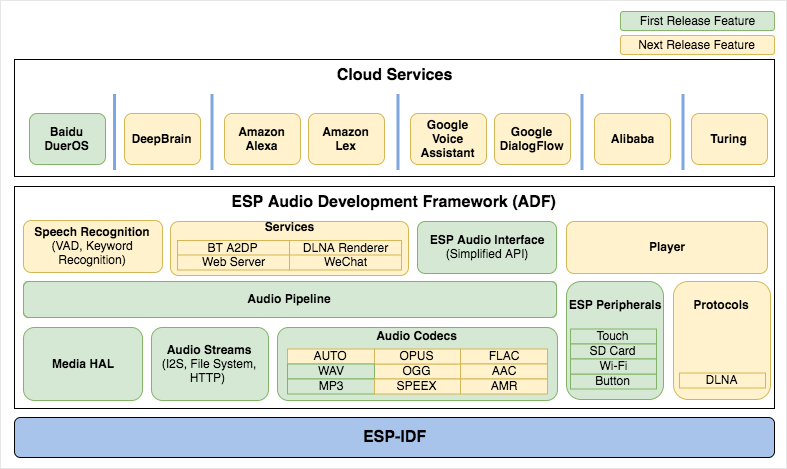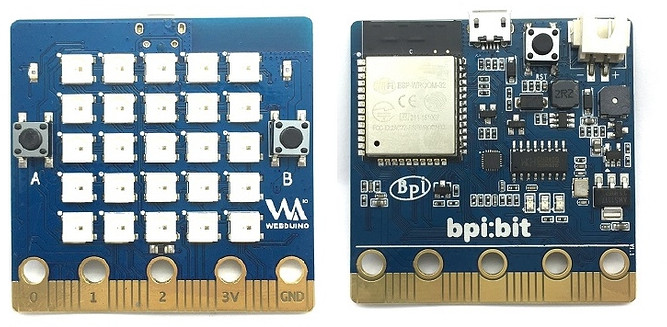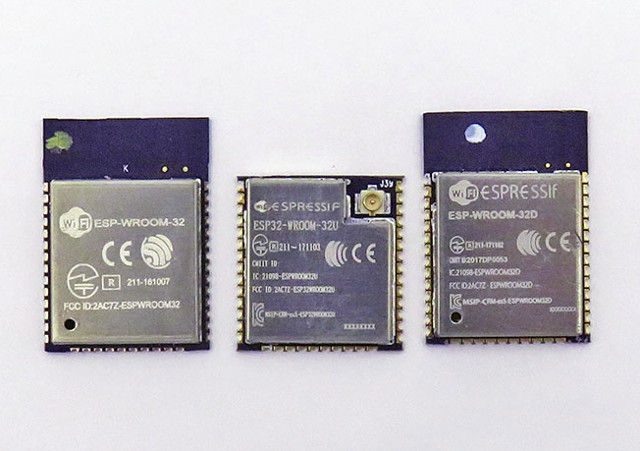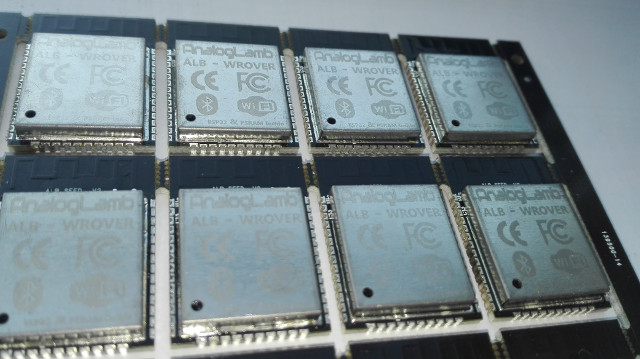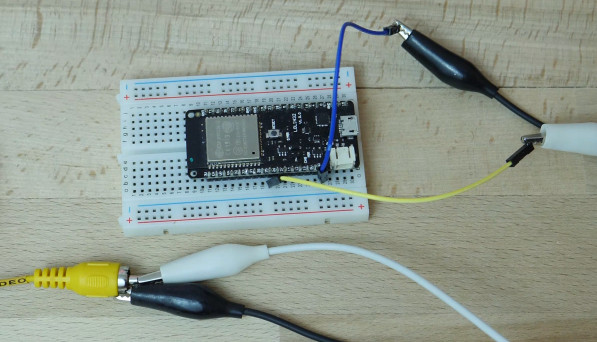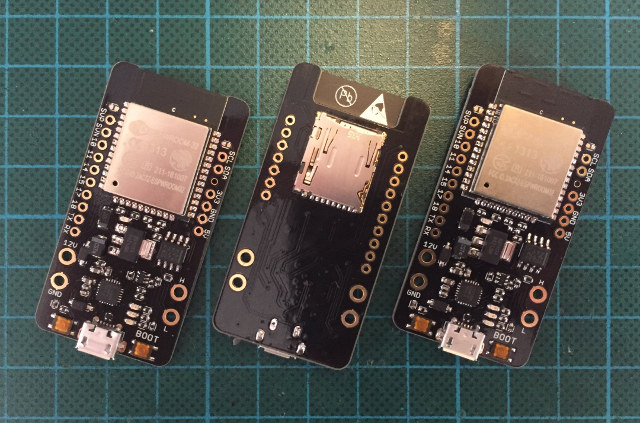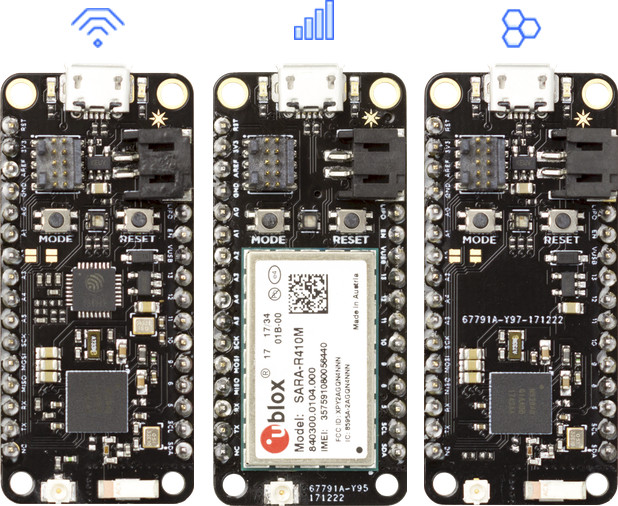Espressif Systems have been working on audio applications like Smart Speakers based on ESP32 WiSoC with hardware development kits like ESP32-LyraTD-MSC Audio Mic HDK, and I could test it with Baidu DuerOS using Mandarin language. However, at the time (February 2018), there was not much else that could be done with the hardware kit, since no corresponding ESP32 audio software development kit had been made available. This has now changes since Espressif has just released ESP-ADF Audio Development Framework on Github. The framework will support the development of audio applications for the Espressif Systems ESP32 chip such as: Music player or recorder handling MP3, AAC, WAV, OGG, AMR, SPEEX … audio formats Play music from network (HTTP), storage (SD card), Bluetooth A2DP/HFP Integration with Media services such as DLNA, Wechat, etc.. Internet Radio Voice recognition and integration with voice services such as Alexa, DuerOS, Google Assistant As we can see […]
$19.50 BPI:bit ESP32 Board is Inspired by BBC Micro:bit, Compatible with Webduino and Arduino IDE
BBC micro:bit board for education was first unveiled in 2015, before starting to be given away to UK students, and later sold for about $19 in 2016. The board supports Bluetooth connectivity, includes an array of 25 LEDs, as well as a specific 20-pin edge connector also featuring 5 large holes (rings) for 3 I/Os and power. So far I had not seen any clones or alternative boards inspired from the design, as we see for Arduino or Raspberry Pi boards. But SinoVoIP (Banana Pi) has changed that with their BPI:bit clearly inspired from the Micro:bit, but offering both WiFi and Bluetooth connectivity via an ESP32 module. Hardware specifications: Wireless module – ESP-WROOM-32 module with WiFi and Bluetooth LE connectivity LEDs – 25x RGB LED array Sensors – 2x light sensors, thermistor, 9-axis accelerometer / gyroscope / compass (MPU-9250) Expansion – 3 digital/analog I/O rings, 3V/GND ring, 20-pin edge connector […]
ESP32-WROOM-32D / ESP32-WROOM-32U WiFi & Bluetooth Modules Deliver Better RF Performance
ESP-WROOM-32 is likely the most popular ESP32 WiFi + Bluetooth module on the market, but a few months ago, Espressif Systems unveiled two variants named ESP32-WROOM-32D / ESP32-WROOM-32U, which are based on ESP32-D0WD (5x5mm package) instead of ESP32-D0WDQ6 (6x6mm package), and are said to offer better RF performance ESP32-WROOM-32D is the most similar to ESP-WROOM-32 since it also comes with a PCB antenna, while ESP32-WROOM-32U is much smaller as it relies on an external WiFi/Bluetooth antenna via a u.FL connector. Both new modules are pin-to-pin compatible with ESP-WROOM-32 Key features: CPU – Espressif ESP32-D0WD dual core Tensilica processor Storage – 32Mbit SPI flash Crystal – 40 MHz Connectivity – Wi-Fi 802.11 b/g/n up to 150 Mbps, Bluetooth 4.2 LE I/Os – 38- catellagated pin with I/Os + GND plane Antenna ESP32-WROOM-32D – on-board antenna ESP32-WROOM-32U – u.FL connector for external IPEX antenna Dimensions ESP32-WROOM-32D – 18 x 25.5 x 3.1 […]
ALB32-WROVER is an ESP-WROOM-32 Compatible Module with 32 Mbit PSRAM, up to 128 Mbit Flash
ESP-WROOM-32 is one of the most commonly ESP32 WiFi + Bluetooth module, and does the job for many applications. However, it only includes 4MB (32Mbit) flash, and no external PSRAM, while Espressif ESP32 chip itself supports up to 128 Mbit (16MB) NOR flash and up to 32Mbit (4MB) PSRAM, so for applications demanding more resources (e.g. MicroPython), or for initial development it would good to have a module maxing out memory and storage capabilities of the chip. Analog Lamb ALB32-WROVER does exactly that with 32 Mbit PSRAM, and 32 to 128 Mbit flash, in a form factor compatible with ESP-WROOM-32 module. ALB32-WROVER specifications: WiSoC – Espressif ESP32 (Rev0?) Wi-Fi and Bluetooth combo chip External Memory – 32Mb PSRAM Storage – 32, 64, or 128Mbit Flash Dimensions – 18 x 25 x 3 mm Compatible with ESP-WROOM-32, except for GPIO16 & 17 (used for PSRAM) It’s very odd the company claims the […]
3D Rendering and Video Composite Output on ESP32 Boards
A few years ago, we already saw it was possible to transmit color signals over NTSC using an ESP8266 board with the signal received on a TV with an analog tuner. CNLohr had to connect an antenna to the I2S pin of his ESP8266 module, and disable WiFi. But surely we should be able to do the same with ESP32, and potentially even better thanks to the two cores. That’s exactly what Bitluni successfully managed by connecting his LoLin32 board to the composite input of his TV with one handling the TV signal output (in grayscale) and the other core rendering 3D objects in real-time. But any ESP32 board could be use instead. The hardware connection is very easy. We just need two wires, one connected to the GND pin and outer part of the RCA connector, and the other connected to GPIO 25 (DAC1) and the inner part of […]
A First Look at ESP32-LyraTD-MSC Audio Mic HDK with Baidu DuerOS Assistant
Earlier this year, Espressif Systems had unveiled their ESP32-LyraTD-MSC Audio MiC HDK (Hardware Development Kit) which features an ESP32-WROOM module, a 4-mic array DSP, 3 microphones, an audio jack, and various I/Os. I received the board a couple of weeks ago, and while there’s no public information released yet, the company provided me with ESP32-LyraTD-MSC User Guide in English. Eventually, I’d expect Google Assistant and Amazon Alexa to be supported, but in the meantime I had to leverage my (lowly) Chinese language skills to get started since the kit is pre-loaded with firmware connecting to Baidu DuerOS voice assistant. ESP32-LyraTD-MSC Unboxing The kit came in a bland Espressif Systems carton box. Inside the package, I could only find one kit comprised of two boards. The bottom board read ESP32_MicrosemiDSP_Mainboard-V1, and does not show much apart from marking for connectors, headers and the power switch. While the top comes with eight […]
CAN32 ESP32 Development Board is Designed for CAN Bus Applications
If you want a WiFi + BLE board to play with CAN bus, one option is to go with the versatile Olimex ESP32-EVB Board, but if you need something more compact CAN32 board might be worth a look as the board is specifically designed for projects and testing of the ESP32 in a CAN-BUS environment. CAN32 board hardware specifications: Wireless module – Espressif Systems ESP32-WROOM WiFI + Bluetooth LE module External storage – micro SD slot CAN Bus chip – Texas Instruments SN65HVD230DR CAN-BUS transceiver with sleep mode Expansion Unpopulated headers exposing: SVP/SVN, GPIOs, I2C, UART, GND, 3.3Vm 5.0V 4 larger vias for CAN H and L, 12V (max 15V), and GND Debugging / Programming – micro USB port via Silicon Labs CP2102N USB to UART Misc – C&K soft-touch low-profile buttons for reset and boot; 4x LEDs for power, ESP, UART Tx/Rx Power Supply 5V via micro USB port […]
Particle Unveils Three nRF52840 Bluetooth 5 Boards: Argon (WiFi), Boron (LTE), and Xenon, as well as Particle Mesh Technology
In the last year or so, Bluetooth has gotten an upgrade with the release of Bluetooth 5. The new protocol works on several existing platforms, but if you want support for the full set of Bluetooth 5 features such as longer range and higher bandwidth, we’ve seen you need a recent chip such as Nordic Semi nRF52840. However so far, AFAIK you had to buy Nordic Semi own development kit for play with nRF52840, and now Particle has announced not one, but three low cost development boards powered by nRF52840 chip starting at just $9, and supporting their newly announced Particle Mesh technology. So for some reasons, it appears they did not go with Bluetooth Mesh. Particle Xenon – Bluetooth 5 + Mesh Xenon is the cheapest model with the following specifications: SoC – Nordic Semiconductor nRF52840 Arm Cortex-M4F 32-bit processor @ 64MHz with 1MB flash, 256KB RAM Storage – […]


